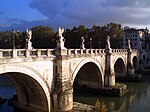Ponte Fabricio
Bridge

According to Dio Cassius, the bridge was built in 62 BC, the year after Cicero was consul, to replace an earlier wooden bridge destroyed by fire. It was commissioned by Lucius Fabricius, the curator of the roads and a member of the gens Fabricia of Rome. Completely intact from Roman antiquity, it has been in continuous use ever since.
The Pons Fabricius has a length of 62 m, and is 5.5 m wide. It is constructed from two wide arches spanning 80 feet, supported by a central pillar in the middle of the stream. The arches of this bridge are the first ones on any Roman bridge that were not semi-circular. This is possibly caused by the semi-circle being located below the water line. Its core is constructed of tuff. Its outer facing today is made of bricks and travertine. A relief is located 20 feet above the pier. During times of flood, this relief served as an additional waterway.
Inscription

An original inscription on the travertine commemorates its builder in Latin: L . FABRICIVS . C . F . CVR . VIAR | FACIVNDVM . COERAVIT | IDEMQVE | PROBAVIT ("Lucius Fabricius, son of Gaius, superintendent of the roads, took care and likewise approved that it be built"). It is repeated four times, once on each side of each arch.
A later inscription, in smaller lettering, records that the bridge was restored under Pope Innocent XI, probably in 1679.
See also
- Ponte Milvio – Ancient Roman bridge, a landmark of Rome, Italy
- List of Roman bridges
- List of ancient monuments in Rome
- Roman architecture
- Roman engineering
References
- ^ Rabun M. Taylor (2000). Public Needs and Private Pleasures: Water Distribution, the Tiber River and the Urban Development of Ancient Rome. L'ERMA di BRETSCHNEIDER. pp. 141–. ISBN 978-88-8265-100-8.
- ^ Claridge, Amanda (1998). Rome: An Oxford Archaeological Guide. Oxford: Oxford Univ. Press
- ^ Whitney, Charles S. (2003-01-01). Bridges of the World: Their Design and Construction. Courier Corporation. pp. 61–63. ISBN 978-0-486-42995-3.
Sources
- O’Connor, Colin (1993), Roman Bridges, Cambridge University Press, p. 66, ISBN 0-521-39326-4
External links
- LacusCurtius: Pons Fabricius
- Pons Fabricius at Structurae
- The Waters of Rome: Tiber River Bridges and the Development of the Ancient City of Rome Archived 2008-09-16 at the Wayback Machine
- Tiber Island information (in Italian)
- Ponte Fabricio Archived 2011-09-29 at the Wayback Machine (in Italian)
- Lucentini, M. (31 December 2012). The Rome Guide: Step by Step through History's Greatest City. Interlink. ISBN 9781623710088.
![]() Media related to Ponte dei Quattro Capi at Wikimedia Commons
Media related to Ponte dei Quattro Capi at Wikimedia Commons
| Preceded by Pons Cestius |
Landmarks of Rome Pons Fabricius |
Succeeded by Ponte Milvio |
